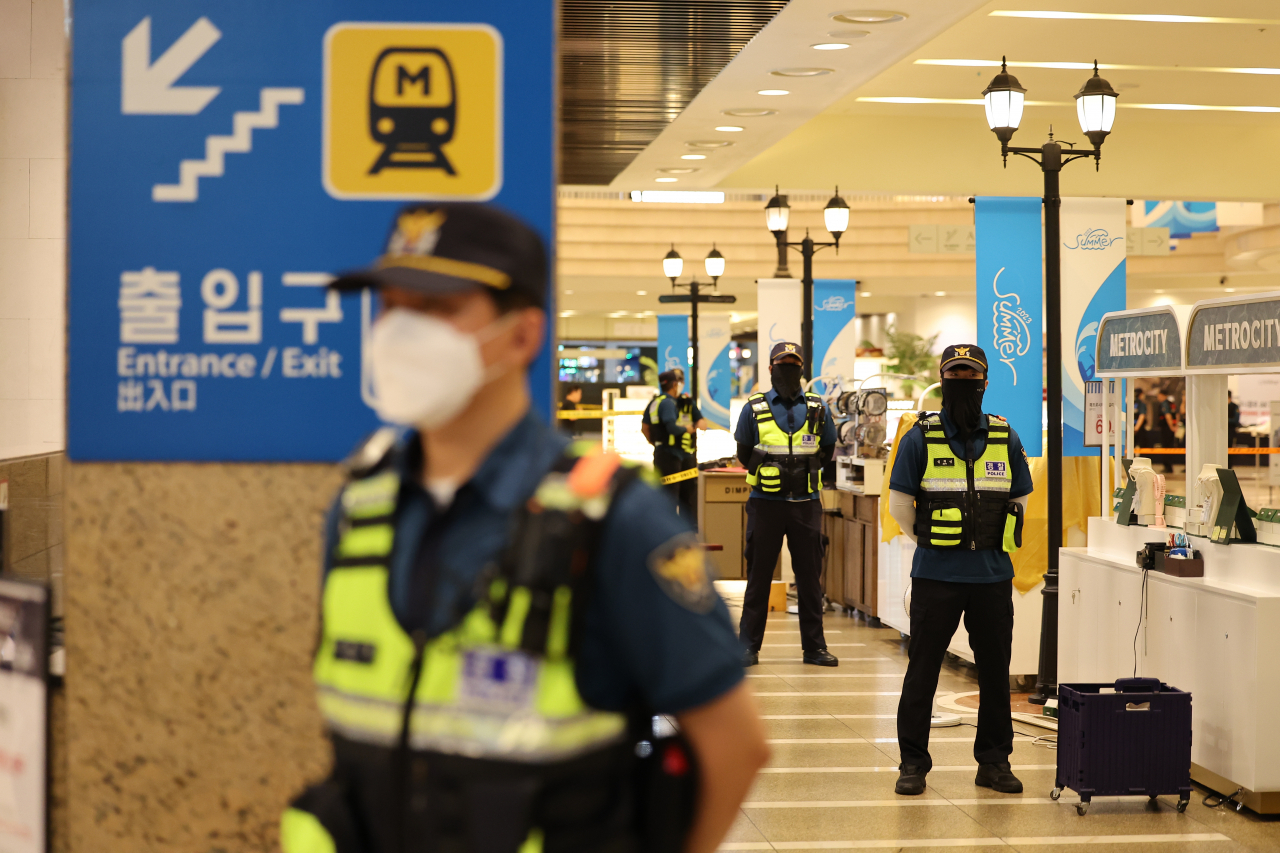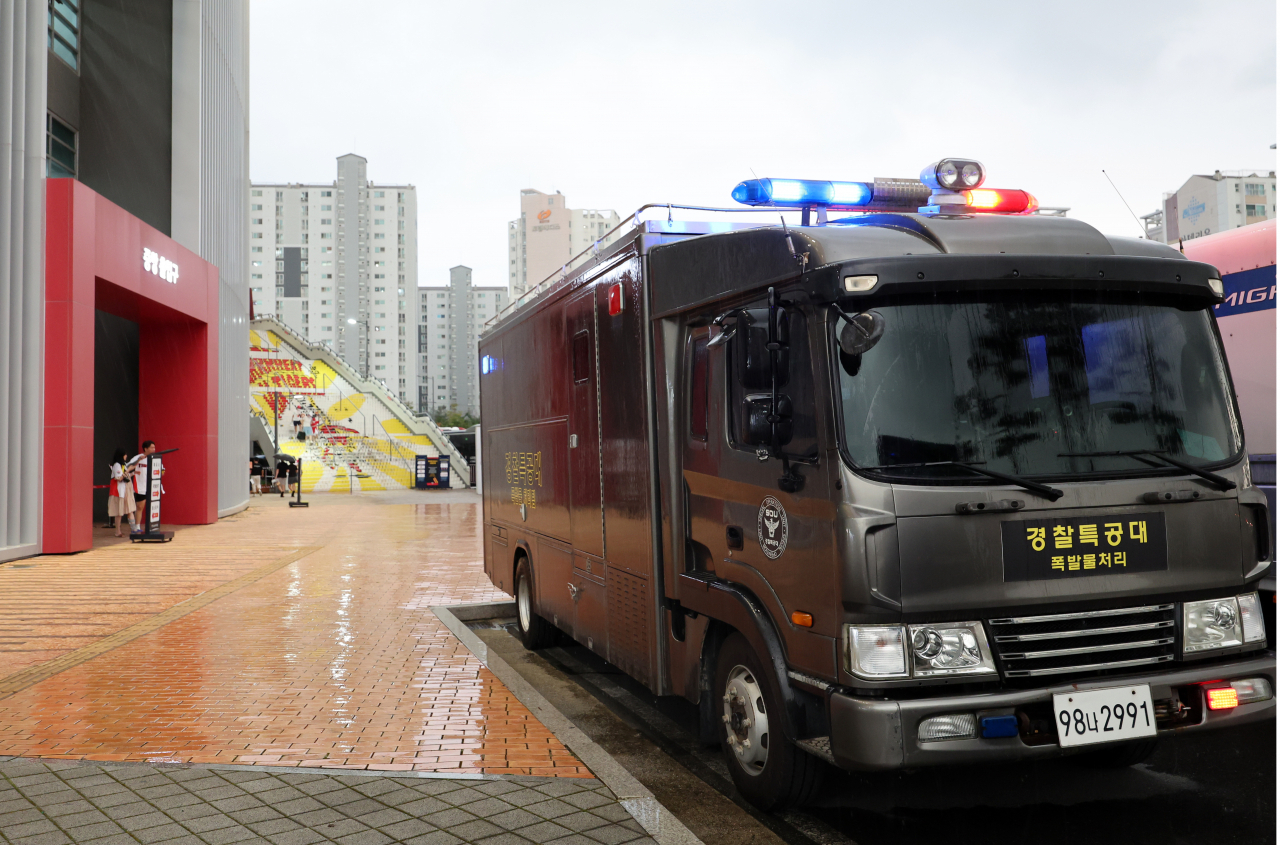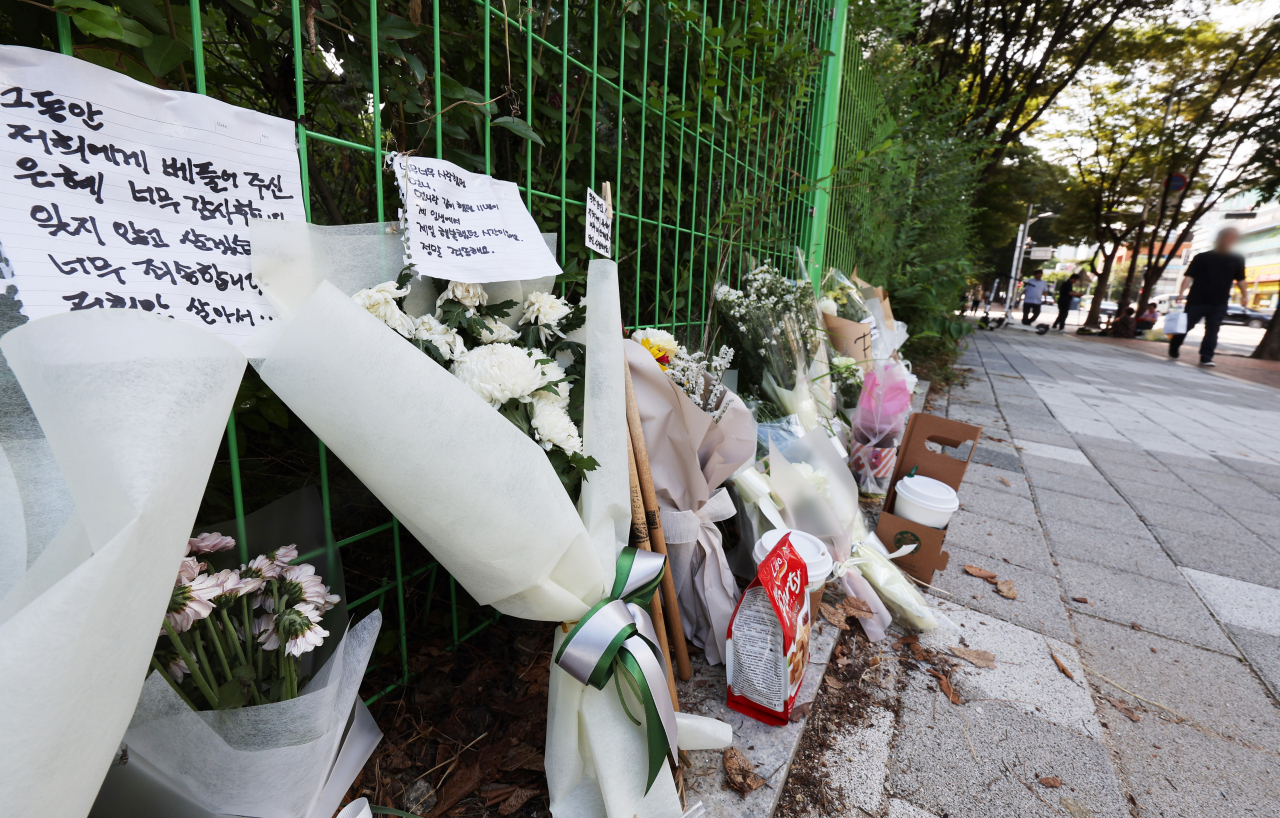 |
Police are patrolling the scene of a knife rampage at Seohyeon Station in Bundang-gu, Seongnam, Gyeonggi Province, on Aug.2. (Yonhap) |
"Less-lethal" guns to be distributed to law enforcement. More security cameras to be installed in parks, streets and public spaces. More frequent police patrols.
These are just some of the measures South Korea has recently announced, as it scrambles for solutions to respond to a spate of apparently unprovoked attacks on members of the public.
“In order to deal with ‘don’t-ask-why crimes’ on the fundamental level, (the government) will restructure police (forces) to maximize their function to retain public order,” President Yoon Suk Yeol said at a Cabinet meeting last week, in which the plan to arm police personnel with nonlethal weapons was approved.
A week before that, Prime Minister Han Duck-soo floated the idea of reintroducing the police conscription system, just three months after the last conscripts had left.
Stabbings lead to crime scare
The summer of 2023 was marred by a series of high-profile crimes in South Korea.
It began with a July 21 knife attack near Sillim Station, Seoul, that killed one and injured three. The culprit, a 33-year-old named Jo Seon, said he wanted to “make others miserable because his life was miserable.”
On Aug. 3, a 22-year-old man called Choi Won-jong drove his car into pedestrians near Seohyeon Station in Bundang, Gyeonggi Province. After his tire burst, he got out and attacked people with a knife. He killed two people and injured 12 others in the onslaught.
These crimes were followed by scores of online threats to kill random people, which prompted the police to launch a hunt for the anonymous authors of the threats.
Indicative of the level of public disquiet, a group of screaming BTS fans on the Seoul subway's Line No. 9 on Aug. 6 panicked other passengers. Scores were injured as they rushed to exit the train, desperately trying to escape from whatever caused the sudden screams.
The Seohyeon Station attack was a shock to one 27-year-old Bundang resident on a more personal level.
“As a long-time resident of Bundang, Seohyeon Station is somewhere I’m very familiar with, somewhere I’ve frequently visited since I was little,” she said. “I don’t think I will ever feel the same in that place.”
South Koreans have long taken pride in their country’s strict control on guns and violence, which, coupled with extensive surveillance camera coverage in major cities, have made the nation a relatively safe place to live.
But polls show that many Koreans no longer feel safe.
An August poll by Gallup Korea on 1,001 South Korean adults showed that 52 percent of respondents felt “very worried” that they would be victimized by random attacks, while 30 percent said they were “somewhat worried.”
It also showed that a larger proportion of women were worried (63 percent) about the issue compared to men (40 percent).
 |
Police bomb disposal team is dispatched at the KBO game between LG Twins and Kia Tigers held Aug.8 at the Gwangju Kia Champions Fields in Gwangju, 270 kilometers south of Seoul, where an anonymous bomb terror threat had been made earlier. (Yonhap) |
Motive lacking
Local media have labeled the recent incidents as "don’t-ask-why" crimes, a description used for crimes without a clear motive or connection between the perpetrator and the victim.
Ironically, experts and officials are now fixated on understanding the “whys" -- why some people act this way and why it seems to be becoming more common.
Kim Jin-hyeok, professor of police science at Kyungnam University, says such crimes could be characterized by a passing fury.
“Suffering from accumulated anger and extreme stress, people tend to regain their psychological stability by taking out their stress on others. When they can’t find a proper target for relieving their anger, they commit physical violence toward unspecified individuals,” Kim wrote in his study, “Types of Random Crime and Countermeasures.”
The socially isolated, he pointed out, often get caught up in their own world in processing such thoughts, losing the capacity to think in an objective way. This can lead to a misdirection of their anger and frustration.
In the Sillim stabbing case, Jo said he was angered by feeling inferior toward other men, while Choi claimed that he was a victim of stalking by an unidentified group.
A 2021 study showed that 21.9 percent of the “don’t-ask-why” crimes had occurred out of frustration and anger at their current situation, family or society. A report published in the Korea Criminal Intelligence Review studied 398 cases through Supreme Court rulings, and found that 21.4 percent of such crimes were committed by those with mental illness.
In 43.9 percent of the cases, the culprit had no discernible mental disorder or specific triggers for their action, but they harbored a general discontent toward the society.
“Jo is a typical case of the ‘frustrated and angry’ crime, characterized by the violent nature of the actions and the attempts to rationalize oneself,” said the study’s lead author Ahn Sang-won, who is researcher at Gangwon University’s Crime Research Institute.
Bae Sang-won, a criminal profiler of the National Police Agency, suggested in a recent interview that the media and authorities stop using the “don’t-ask-why” label to refer to what he called “abnormal motive crimes.”
“The term could provoke the people prone to such thoughts to act. In a way, it gives (these people) one way to shift blame onto society,” Bae said.
He stressed that these crimes must be studied more carefully and thoroughly, rather than shelving them into one category as “motiveless.”
For ordinary people, the difficulty of understanding "don’t ask why" crimes is what makes them more frightening. Both Jo and Choi, the individuals responsible for the fatal knife attacks, were unaware of their victims' identities and showed no concern for them. The apparent randomness in their target selection implies that anyone could have been their victim.
New approach needed
The recent spate of high profile crimes comes amid an extended decline in violent crime. Police statistics show that incidences of homicide have been declining, from 905 in 2017 to 641 in 2021, against a population of over 51 million.
The number of violent crimes, which encompass robbery and sexual violence, also fell from 27,274 to 22,476 over the same period.
The United Nations Office on Drugs and Crime put South Korea among the lowest ranking nations in terms of homicides, with 0.5 per every 100,000 people in 2021. Bahrain and Singapore (0.1), Japan and Oman (0.2) were among the few with lower figures.
South Korean police solved 96.7 percent of homicides in 2021, according to the National Police Agency, compared to about 50 percent in the United States.
As of 2022, there were a little over 1.6 million CCTV cameras installed by public organizations across the nation, with countless more installed by the private sector.
But experts stress that a new approach is needed for "don’t-ask-why" crimes.
 |
Flowers and letters paying tribute to those who lost their lives in the Aug. 3 stabbing rampage are lain at the scene of the crime, near a department store at Seohyeon Station in Bunsdang, Gyeonggi Province. (Yonhap) |
Even as Choi plowed his car into a crowd and attacked innocent passersby with a knife, his every move was filmed by security cameras in Bundang, one of the most affluent regions outside of Seoul. The Sillim attack was also recorded on security cameras in the area.
These attacks showed that a high number of CCTV cameras and a high rate of solving murders can only do so much to prevent outbursts of violence.
More studies are needed to formulate an effective response to these types of crimes, and this should encompass the understanding that there might be larger societal factors and underlying issues contributing to the recent surge in crimes with abnormal motives.
The aforementioned Gallup poll showed that 55 percent of respondents thought that “problems in the society” lead to violent crimes, while 36 percent said “the inherent nature of the criminals” is chiefly to blame.
Last week, local media reported that the Seoul Metropolitan Police Agency has compiled a report outlining its strategies for addressing crimes with abnormal motives, based on analyses conducted by criminal profilers. This reportedly includes guidelines for identifying potential threats and utilizing profiling techniques to assess perpetrators behind such incidents.
A study by Yoon Jeong-sook, researcher for the state-run Korea Institute of Criminology and Justice, showed that 75 percent of the perpetrators of these crimes had previous criminal records. Jo, responsible for the Sillim killings, had a record going back to his childhood.
Yoon stressed that education on socializing skills and psychological treatments are necessary for criminals with antisocial disorders, rather than simply locking them up in prison for long periods of time.







